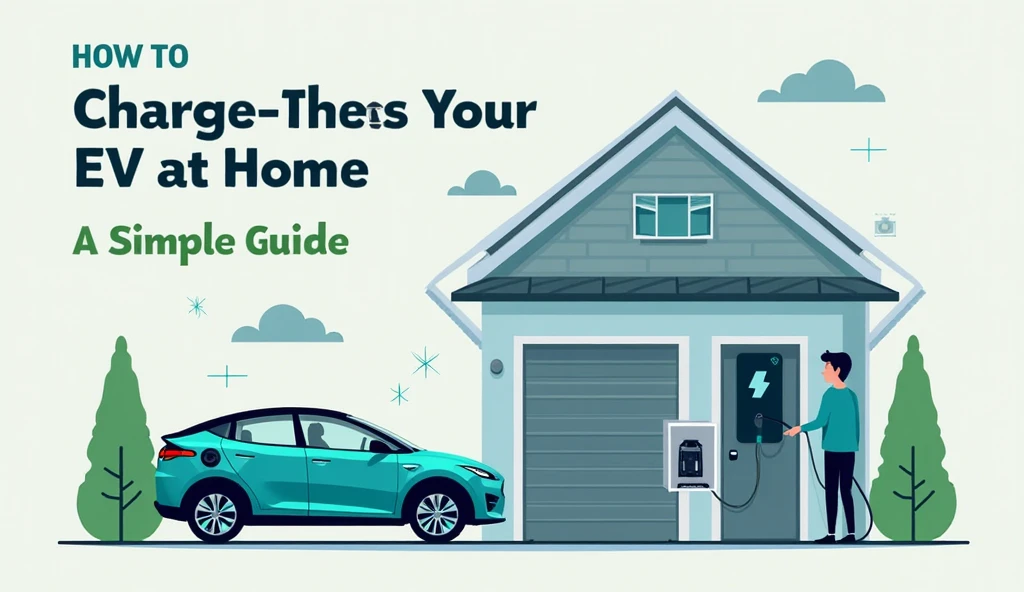
Charging your electric vehicle (EV) at home is one of the biggest advantages of going electric. It’s convenient, affordable, and helps you start each day with a full battery. If you’re a beginner or thinking about getting an EV, this simple guide will explain how home EV charging works, what equipment you need, and how to get started the right way.
1. Why Home Charging Matters
Unlike gas cars that need trips to the pump, electric cars can charge while you sleep. This means you can plug in at night and wake up to a fully charged vehicle every morning.
Benefits of home EV charging include:
- Convenience – no more gas station stops
- Savings – lower cost per mile compared to gas
- Control – charge when electricity rates are lowest
- Peace of mind – avoid public charger delays
2. The 3 Main Types of EV Charging
There are three charging levels, but only two are used at home:
Level 1 Charging (Standard Wall Outlet)
- Uses a regular 120-volt outlet (the same as your phone charger)
- Adds about 3–5 miles of range per hour
- Best for plug-in hybrids or low-mileage drivers
- No special equipment needed
This is the slowest method and may not be ideal if you drive long distances daily.
Level 2 Charging (Most Common for Homes)
- Uses a 240-volt outlet (like a dryer or oven plug)
- Adds 15–40 miles of range per hour
- Charges most EVs overnight in 6–10 hours
- Requires a Level 2 home charger (EVSE) and installation by an electrician
Most EV owners choose this option because it provides a good balance of speed and cost.
Level 3 Charging (DC Fast Charging)
- Adds 100+ miles in 20–30 minutes
- Not available for home use
- Found only at public charging stations due to high power needs
You’ll use fast chargers on road trips or when you need a quick boost, but not at home.
3. What You Need to Charge at Home
To charge your EV at home, you’ll need a few things:
A Parking Space With Power Access
You’ll need a garage or driveway with access to an outlet or wiring. Apartments may require landlord permission or a shared charging solution.
The Right Charging Equipment
Most EVs come with a Level 1 charging cable. For faster charging, buy a Level 2 charger. Look for:
- UL-listed safety certification
- Smart features (like Wi-Fi, scheduling, or usage tracking)
- Compatibility with your EV’s plug (most use J1772, while Teslas need an adapter)
Popular home chargers include ChargePoint Home Flex, JuiceBox, Grizzl-E, and Wallbox Pulsar Plus.
Professional Installation
For Level 2 charging, you’ll need a 240V outlet installed by a licensed electrician. They may also upgrade your electrical panel if needed.
Installation costs vary but usually range from $300 to $1,200, depending on your setup.
4. Charging Costs at Home
Charging at home is much cheaper than filling up a gas tank. Here’s what to expect:
- Average U.S. electricity cost: 13–16 cents per kWh
- Cost to fully charge a 250-mile EV: $8–12
- Cost per mile: about 3–5 cents
- Compare to gas cars: 15–20 cents per mile
Tip: Use smart chargers or utility apps to charge at night when rates are lower.
5. Can You Use Solar Panels?
Yes! If you have solar panels, you can charge your EV with clean energy from your roof. This further reduces your carbon footprint and long-term costs.
Some homeowners also add home batteries (like Tesla Powerwall) to store solar power for charging at night.
6. How Long Does Home Charging Take?
Charging time depends on your EV’s battery size and your charger type:
- Level 1: 20–50 hours for a full charge
- Level 2: 6–10 hours for most EVs
- Plug-in hybrids: Much faster due to smaller batteries (2–6 hours)
Pro tip: You don’t need to charge from 0% to 100% daily. Most drivers just top off overnight, like charging a smartphone.
7. Tips for Safe and Efficient Charging
- Always use certified chargers and proper outlets
- Don’t use extension cords unless rated for EV charging
- Mount your wall charger securely and protect it from weather
- Schedule charging for off-peak hours to save money
- Monitor charging via your EV app or charger app
- Keep your charging cable clean and stored safely
8. Are There Tax Credits for Home Charging?
Yes! Through June 2026, you can get a 30% federal tax credit (up to $1,000) for home charger installation. That includes hardware and labor costs.
Check also for state and utility company rebates, which can save you hundreds more.
9. What If I Live in an Apartment?
If you live in a condo or apartment, charging can be more complex. Here are some options:
- Use a Level 1 charger if you have access to an outlet
- Ask your landlord about installing shared chargers
- Look for buildings with EV-friendly amenities
- Use public Level 2 stations near home for regular charging
Some states even have laws requiring landlords to allow EV charging, so check your local policies.
10. Final Thoughts: Charging at Home Is Easy and Smart
Once you set it up, charging your EV at home becomes a habit — just plug in at night and drive off in the morning. It’s cheaper than gas, better for the planet, and more convenient than any gas station.
If you’re ready to switch to electric, a proper home charging setup will make your EV ownership smooth and stress-free.